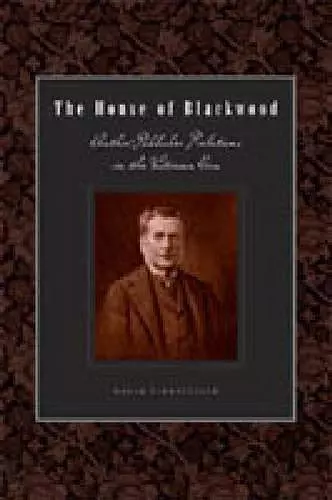The House of Blackwood
Author-Publisher Relations in the Victorian Era
Format:Hardback
Publisher:Pennsylvania State University Press
Published:1st Mar '02
Currently unavailable, and unfortunately no date known when it will be back
This hardback is available in another edition too:
- Paperback£29.95(9780271058368)

This insightful exploration of a historic publishing firm reveals its significant impact on British literature and the intricate relationships with its authors in The House of Blackwood.
In The House of Blackwood, David Finkelstein delves into the rich history of the Scottish publishing firm William Blackwood & Sons, which played a significant role in shaping British literary culture from 1804 to the early twentieth century. This comprehensive study highlights both the triumphs and challenges faced by the firm, offering insights into its extensive archive that reveals the intricacies of its operations and relationships with authors. The depth of the ledger material and the firm's remarkable longevity provide a unique perspective on the publishing industry during a pivotal era.
Finkelstein meticulously traces the evolution of Blackwood, exploring family dynamics across generations and their influence on the political and cultural landscape. He sheds light on the diverse array of authors published by the firm, including notable figures like George Eliot and Joseph Conrad, and examines how The House of Blackwood fostered a distinct audience through its monthly publication, Blackwood’s Magazine. By analyzing the factors contributing to the firm's decline before World War I, Finkelstein paints a nuanced picture of its legacy.
The author employs six case studies to illustrate the relationships between Blackwood and its authors, drawing on extensive correspondence that enriches the narrative. Finkelstein's work not only documents the history of a once-powerful publishing house but also emphasizes the interconnectedness of authors, publishers, and readers, a theme central to the study of book history.
“The House of Blackwood is one of the best studies of a publishing house to be produced since book history was reinvented a couple of decades ago. Perceptively applying theory to archives, Finkelstein’s study illuminates the publisher’s relations to authors, and much more—it shows how successive generations of Blackwoods responded to familial, economic, trade, workshop, and political pressures, the changing demographics of readers, and the altered conditions of publishing in Edwardian Britain. It is a pleasure to read and a model for future work in the field.”
—Robert L. Patten, Rice University
“The House of Blackwood offers as much meat for the nineteenth-century historian, the student of business history—even present-day publishing executives!—as it does for the literary critic.”
—Julie Dawson ForeWord Reviews
“[The book’s] examination of balance-sheets, together with the close reading of correspondence and memoirs, makes an engaging as well as important contribution to our knowledge of the Victorian culture of the book.”
—Leslie Howsam The Library
“This monograph is a further important addition to [Penn State Press’s] significant series on the history of the book.”
—William Baker Papers of the Bibliographical Society of America
“I should finally mention that this is an exceptionally well documented study.”
—Alan Boehm Libraries and Culture
“The House of Blackwood is an engaging and extremely valuable piece of research that will benefit literary scholars and publishing historians for years to come.”
—Karen Carney Sharp News
“Elegantly designed and illustrated, beautifully written, and full of fresh material presented in a lively manner, The House of Blackwood is a notable addition to Victorian publishing history.”
—Solveig C. Robinson Victorian Periodicals Review
ISBN: 9780271021799
Dimensions: 229mm x 152mm x 21mm
Weight: 567g
208 pages